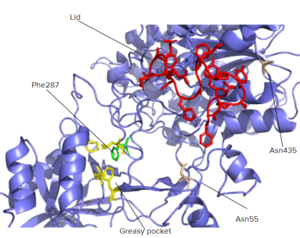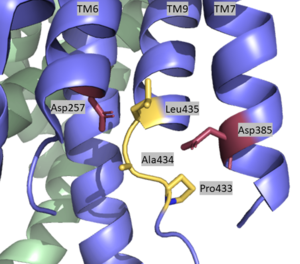Gamma Secretase
Introduction
Background
Gamma Secretase is a transmembrane aspartate protease. It catalyzes peptide bond hydrolysis of type I integral membrane proteins such as Notch, APP, and various other substrates. It recognizes and catalyzes the reaction with its substrate using 3 residue segments. These substrates generate amyloid-β (Aβ). This product is important for various neural processes, and it is well known for its Implications with Alzheimer’s disease (AD). This has made gamma secretase a popular drug target, specifically using gamma secretase (GS) inhibitors. However, due to the nature of gamma secretase having various neural functions, there are dangerous side effects when it is inhibited.
Overall Structure
Gamma-secretase is composed of 20 transmembrane components (TMs) and has 4 subunits: Nicastran, Anterior Pharynx-defective 1, Presenilin, and Presenilin Enhancer 2. These subunits are stabilized by hydrophobic interactions and 4 phosphatidylcholines.These phosphatidylcholines have interfaces between: PS1 and PEN-2, APH-1 and PS1, APH-1 and NCT.
Nicastrin (NCT) has a large extracellular domain and 1 TM. It is important to substrate recognition and binding.
Presenilin (PS1) serves as the active site of the protease and contains 9 TMs, each varying in length. The site of autocatalytic cleavage is located between TM6 and TM7 in PS1 and major conformational changes take place in this subunit upon substrate binding.
Anterior pharynx-defective 1 (APH-1) serves as a scaffold for anchoring and supporting the flexible conformational changes of PS1
Activation of the active site is dependent on the binding of Presenilin enhancer 2 (PEN-2). PEN-2 is also important in maturation of the enzyme.
Structural highlights
Substrate Structure
Though gamma secretase has multiple substrates, the substrate of main concern is called Amyloid Precursor Protein (APP). APP is composed of an N-terminal loop, a transmembrane (TM) helix, and a C-terminal β-strand. The uses lateral diffusion as a mechanism of entry into the enzyme, and once in place, the TM helix is anchored by hydrogen bonds. In order to differentiate substrates, the β-strand is often the main point of identification for the enzyme. After this, the helix undergoes unwinding and the process of catalysis can begin.
Lid Complex

Lid Complex of Gamma Secretase
Lid is the first point of entry and recognition for the substrate. This lid complex is located within the NCT subunit between Asn55 and Asn435. This lobe is divided into two separate subunits, and Phe287 from large lobe acts as pivot between them. This Phe is further surrounded by Phe103, Leu171, Phe176, and Ile180 of the small subunit, and these residues compose a greasy pocket for that provides an environment for easy movement. The lid consists of 5 aromatic residues which are highly involved with stabilizing the closed conformation. In particular, this conformation is stabilized by Trp164, which has interacts with Pro424, Phe448, and the aliphatic side chain of Gln420. Once the substrate binds and the lid is opened, a charged, hydrophilic pocket is revealed. This pocket contains Glu333 and Tyr337 surrounded by several charged residues, and is involved with further substrate binding and recognition.
Active Site

Active Site of Gamma Secretase
The is located between TM6 and TM7 of the PS1 subunit, which is mainly hydrophilic and disordered. Each of these transmembrane helices has an aspartate residue, , which are located approximately 10.6 A˚ apart when inactive.[1] The PAL sequence of is in close proximity with the catalytic aspartates and is important to substrate recognition. Gamma secretase becomes active upon substrate binding, when TM2 and TM6 each rotate about 15 degrees to more closely associate and the two Asp residues hydrogen bond to each other during catalysis. Asp257 and Asp385 are located 6–7 Å away from the scissile peptide bond of the substrate.
Relevance
Gamma secretase has been determined to be highly involved with diseases such as Alzheimer's disease (AD). In this, beta-amyloid build up leads to amyloid plaques in brain. These plaques then go on to cause severe neural dysfunction over time. Inhibition of γ-secretase could be potential AD treatment, but as stated earlier, this is a hard model to accomplish as gamma secretase is relevant with several different substrates. Complete inhibition would cause other severe problems beyond that of AD, making treatment more difficult than what meets the eye. However, what is known is that there are many different regions that give rise to γ-secretase malfunction when they are mutated. Over 200 of these mutations have been linked to causing AD. In particular, these mutations target so called hot spots on the enzyme and heavily impact the interface between PS1 and APP, affecting the integrity of catalysis and ultimately creating the plaques that impair neural function.


